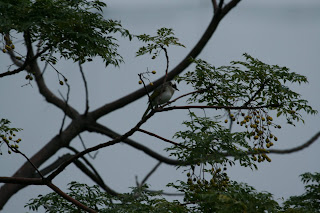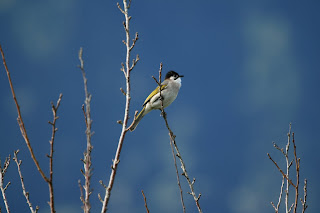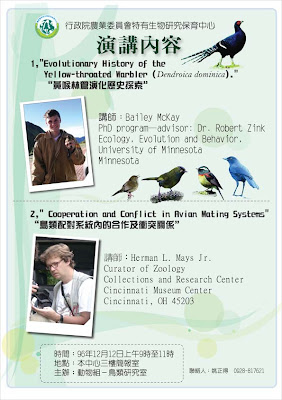Mountain barriers
Mountains are important engines of evolutionary change. A mountain range can present a formidable barrier to movements of animals and divide populations, preventing them from exchanging genes with one another. The division of a single population into two by the gradual introduction of some geographic barrier, like the uplift of a mountain chain, is known as a vicariant event. Vicariance is an important process in evolutionary change and is responsible for much of the biological diversity we see today.
Taiwan has, by all appearances, an excellent example of a vicariant event dividing a single ancestral population into two separate species. The bulbuls are widespread Old-World family of birds (Pycnonotidae).  Taiwan has several members of this avian group including the Chinese Bulbul (Pycnonotus sinensis), a widespread bulbul in East Asia, found both on the island of Taiwan and in Mainland China (see photo left). The Chinese Bulbul's name in Mandarin Chinese is "Bai Tou Wang" which means "white headed old man" after the characteristic white patch on the back of the head. This bird is abundant at low elevations throughout Western and Northern Taiwan where it is considered a crop pest. Farmers often leave fine nets up around their fields that snare these birds in flight and they are left to die hanging tangled in the mesh of the net. A little cruel, yes, but this practice is tolerated largely due to the fact that prohibitions against netting wild birds can be difficult to enforce due to a variety of reasons. Also, the netting occurs in agricultural areas where most of the birds killed in these nets belong to very widespread and common species.
Taiwan has several members of this avian group including the Chinese Bulbul (Pycnonotus sinensis), a widespread bulbul in East Asia, found both on the island of Taiwan and in Mainland China (see photo left). The Chinese Bulbul's name in Mandarin Chinese is "Bai Tou Wang" which means "white headed old man" after the characteristic white patch on the back of the head. This bird is abundant at low elevations throughout Western and Northern Taiwan where it is considered a crop pest. Farmers often leave fine nets up around their fields that snare these birds in flight and they are left to die hanging tangled in the mesh of the net. A little cruel, yes, but this practice is tolerated largely due to the fact that prohibitions against netting wild birds can be difficult to enforce due to a variety of reasons. Also, the netting occurs in agricultural areas where most of the birds killed in these nets belong to very widespread and common species.
There is also another very similar bulbul is found on Taiwan. This is one of the 16 endemic avian species found on Taiwan, the Taiwan or Styan's Bulbul (Pycnonotus taiv anus), found on the east side of the Taiwan Central Mountain Range. This bulbul is very similar to the Chinese Bulbul with a notable exception being the lack of white on the back of the head (see photo right). Because these two species occur on either side of the Taiwan Central Mountain Range they appear to be a classic example of speciation due to a vicariant event, in this case the uplift of Central Taiwan. Different species divided by mountain ranges, bodies of water or other geographic features is a common occurrence among birds and in Taiwan we can see this on a relatively small scale.
anus), found on the east side of the Taiwan Central Mountain Range. This bulbul is very similar to the Chinese Bulbul with a notable exception being the lack of white on the back of the head (see photo right). Because these two species occur on either side of the Taiwan Central Mountain Range they appear to be a classic example of speciation due to a vicariant event, in this case the uplift of Central Taiwan. Different species divided by mountain ranges, bodies of water or other geographic features is a common occurrence among birds and in Taiwan we can see this on a relatively small scale.
However, the two species do have a zone of contact in Southern Taiwan where their ranges overlap and they hybridize so their genetic isolation is incomplete. Taiwan and Chinese Bulbul seem to be a case of vicariance in action but recent work suggests that despite their differing appearance there are few genetic differences between these species. These birds are great subjects for future research and genetic comparisons of these species can potentially tell us much about how new species form.
-END

